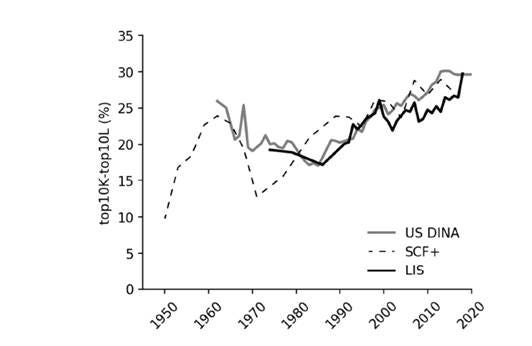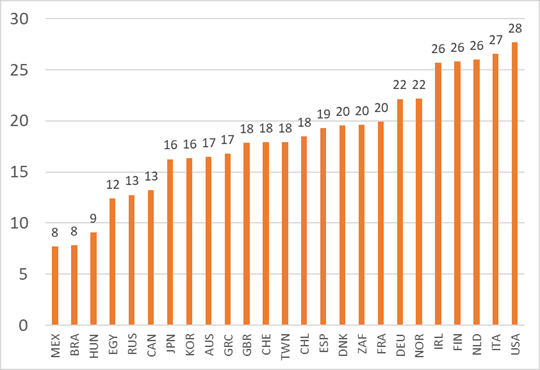Richest capitalists and richest workers are increasingly the same people
Branko Milanović is an economist specialised in development and inequality. His newest book is “Capitalism, Alone: The Future of the System That Rules the World”. His new book, The Visions of inequality, was published October 10, 2023.
Cross-posted from Branko Milanović’s Substack
I called it “new capitalism” in my 2019 book Capitalism, Alone. What is new? In classical capitalism of the 19th century European economists, capitalist societies were composed of two classes: those who own capital (or in Marxist terminology, “the means of production”) and those who do not, and to survive sell their labor power to capitalists. That was a rough, but not incorrect, sketch of the world as it existed in advanced economies in the 19th and early 20th century. (In less advanced economies, ownership of land and political power often associated with land ownership played a bigger role).
That capitalism changed in the twentieth century with the advent of what many called a new “managerial” class. The rise of managers –-people who neither own the means of production nor are simple laborers, but manage the means of production for capitalists lazily playing golf in Florida—was announced by James Burnham’s classic in 1941, and then further developed by Joseph Schumpeter, Raymond Aron, John Kenneth Galbraith, and Daniel Bell, among others, in the 1960s and 1970s; continuing in the same vein. There is also a recent book Managerial Capitalism: Ownership, Management and the Coming New Mode of Production, by Gérard Duménil and Dominique Lévy. For its critical discussion see, Nicole Aschoff in Jacobin.
The perception of capitalism as a three-class society, with managers rising to be the new ruling class, drew on the contrast that Marx saw, but never fully resolved, between two functions played by the capitalist: the provider of the means of production and the organizer of their use (or put differently in Walrasian language, capitalist and entrepreneur). Logically, the two functions could be separated, and in fact they did become separate. That separation—it was argued by the authors I mentioned—created a new, third, class: that of managers. A very nice recent paper by Alexandre Chirat discusses the phenomenon from the Marxist point of view.
But the managerial revolution was overblown. It never happened and it is not happening. Managers as such never succeeded in creating a third class. What happened instead, as I argued in my 2019 book and several new papers confirm, is the rise of a homoploutic elite in the United States, in particular, and also in other rich capitalist economies. What is homoploutia? As often when faced with a new phenomenon, we resort to coining a new term by using Greek words: “same wealth”, or wealthy both in terms of the so-called “human capital” and thus labor income, and in terms of productive and financial capital and thus income from ownership. Homoploutic elite is composed of people who are simultaneously among the richest capitalists and richest (best paid) workers. They may be financial sector CEOs, engineers, doctors, software developers (and hence receiving high salaries) and at the same time having large financial wealth that generates sufficiently high capital income to place them at the top of capital income distribution. They might have inherited that money, or they might have saved over their lifetime out of their high salaries, enough to transform themselves into the richest capitalists. We do not know the relative importance of the two channels, because the area of research is new, and nobody has yet used longitudinal data that should, in principle, allow us to answer that question.
Empirically, we look at homoploutia in the following way. We take the richest decile (ten percent of people) by their after-tax income in the United States and calculate how many of them are at the same time among the richest decile by labor income and among the richest decile by capital income. Note that under classical capitalism, we would expect that almost everybody who is in the top decile by total income would draw most of their income from ownership of capital, but almost nobody would be among the highest paid workers. So being rich and being capitalist was synonymous. In fact, this is exactly what we still find today in less advanced capitalist economies like Brazil or Mexico.
In more advanced capitalist economies such as the United States, we find that almost a third of the income-rich people are both among the top decile of workers (that is, when people are ranked by their labor income only) and among the top decile of capitalists (that is, when people are ranked by their capital income only). Moreover, we find that the importance of homoploutia has continuously risen in the past forty years.
The graph below, from a paper by Yonatan Berman and myself, documents this using three different data sources: US Current Population Census which is the premier US income survey (as standardized by Luxembourg Income Survey; LIS), Survey of Consumer Finance (a survey that concentrates both on wealth and income distributions in the US) and DINA (Distributional National Accounts) developed originally by Thomas Piketty, Emmanuel Saez and Gabriel Zucman that combines fiscal, survey, and national accounts data. All three tell the same story: the share of the homoploutic rich has risen from a fifth of the top decile in the 1980s to almost a third now. Moreover, Berman and I estimate that about 20% of the increase of US income inequality between 1980 and today can be explained by the rising homoploutia as such, that is, holding all other factors constant and letting only the association of high labor and capital income in the same persons increase. Homoploutia’s effect is stronger than the effect of increased capital share. To put it simply: it is not just that the capital share in the United States went up; more importantly, it is that this rising capital share accrued to the people whose salaries were already high. The stories of rising income inequality can no longer ignore this development.

Note: The figure shows the share of people in US top income decile who are among the richest capitalists (top decile by capital income) and richest workers (top decile by labor income.
Why does homoploutia matter? It might seem a welcome development as it erases the class distinction between capital and labor. We have here people who in their own personae extinguish that crucial distinction that was the source of class warfare and revolutions. What is wrong with it? Shouldn’t this development be welcomed and cheered? Yes, in some ways, but not in many others. What homoploutia also is, is the creation of a new elite that is resistant to shocks in labor and capital markets and thus able to maintain its position even if the rate of return on large capitals (like theirs) goes down, or if their particular highly-skilled jobs suddenly pay less. It is an elite, resistant to macroeconomic shocks, composed of highly-skilled people who have attended the best schools and probably feel to have deserved their superior position. In contrast to the old-fashioned capitalists, the homoploutic elite feels that it merits its high incomes: they might conveniently forget the capital part of that income, and focus solely on the labor part for which they have studied hard and worked hard. Three things are linked here: ownership of lots of capital, high level of education, and a highly paid job. Thus, instead of a class-based society of the old capitalism, we now have an elite-ruled society. In their own personae, they transcend the contradiction between capital and labor but achieve this only at the “cost” of distinguishing themselves from the rest of the population, that is by creating an elite sitting atop of society.
The new capitalism is in evidence in all advanced countries. The figure below, calculated from Luxembourg Income Survey (LIS) data, shows the percentage of the people in the top income decile who are homoploutic: the share ranges from almost 30 percent in the United Stats and Italy to 16 percent in Japan and South Korea. But in the less advanced capitalist countries (Hungary, Brazil, Mexico) it is below 10 percent. Incidentally, and perhaps importantly, data for China in 2013, show the homoploutic share to exceed that of any other country, at 32 percent.

Note: The graph shows the percentage of labor-rich households who are also capital-rich (in top decile by labor income and in top decile by capital income) based on LIS data for the years 2015-18
The elite will be fully formed and impregnable when perhaps 80 or 90 percent of the richest income decile becomes homoploutic. The class divided society of the yore would disappear by giving way to an elite-ruled society for which economic and political theories of the elite domination may be more relevant than the simple Marxist class analysis.



Be the first to comment